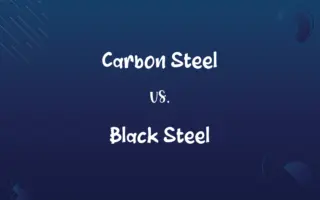Clay vs. Ceramic: Know the Difference

By Shumaila Saeed || Published on December 25, 2023
Clay is a natural, malleable soil material, whereas ceramic is a hardened, shaped, and fired clay product.

Key Differences
Clay is a naturally occurring earth material, often found in deposits near water sources, known for its plasticity when wet. Ceramics, on the other hand, are a broad category of materials, including earthenware, porcelain, and stoneware, created by shaping and then firing clay at high temperatures.
Shumaila Saeed
Dec 25, 2023
The primary use of clay is in its raw form for pottery, sculpture, and construction, where its moldability and cohesiveness are key properties. Ceramic refers to the finished, often hardened and glazed, product of fired clay, used in a wide range of applications from tableware to engineering.
Shumaila Saeed
Dec 25, 2023
In its raw state, clay can be shaped and reshaped; its versatility allows for creativity in design and function. Once clay is transformed into ceramic through firing, it becomes rigid and permanent, losing its malleability but gaining strength and durability.
Shumaila Saeed
Dec 25, 2023
Different types of clay, such as kaolin, bentonite, or ball clay, have varying properties and uses. Ceramics, depending on the type of clay used and the firing process, can vary greatly in texture, strength, and aesthetics, from rustic terracotta to fine bone china.
Shumaila Saeed
Dec 25, 2023
Clay, when mixed with water, can be a medium for artistic expression, its texture and form are easily manipulated by hand or tools. Ceramic, especially when glazed, offers a waterproof, often decorative surface, and is used in various forms like tiles, dinnerware, and art pieces.
Shumaila Saeed
Dec 25, 2023
ADVERTISEMENT
Comparison Chart
Uses
Pottery, sculpture, construction
Tableware, tiles, art, engineering components
Shumaila Saeed
Dec 25, 2023
Properties Before Use
Soft, shapeable, responsive to moisture
Non-existent (formed from clay)
Shumaila Saeed
Dec 25, 2023
Properties After Use
Dries and can harden, but not durable like ceramic
Waterproof, durable, and heat-resistant
Shumaila Saeed
Dec 25, 2023
ADVERTISEMENT
Clay and Ceramic Definitions
Clay
It is known for its plasticity when moist.
The artist found the clay easy to shape into intricate forms.
Shumaila Saeed
Dec 12, 2023
Ceramic
It encompasses a range of products like porcelain and earthenware.
Porcelain is a type of fine, high-quality ceramic.
Shumaila Saeed
Dec 12, 2023
Clay
Clay can harden when dried or fired.
The clay sculpture was left to dry overnight.
Shumaila Saeed
Dec 12, 2023
Ceramic
It is used for making pottery, tiles, and art.
Ceramic tiles are popular for kitchen and bathroom floors.
Shumaila Saeed
Dec 12, 2023
Clay
Clay is a natural, fine-grained soil material.
She molded the wet clay into a beautiful vase.
Shumaila Saeed
Dec 12, 2023
ADVERTISEMENT
Ceramic
Ceramic is known for its durability and heat resistance.
Ceramic cookware is ideal for high-temperature cooking.
Shumaila Saeed
Dec 12, 2023
Clay
It's used in making pottery, bricks, and sculptures.
Traditional brick-making relies heavily on clay.
Shumaila Saeed
Dec 12, 2023
Ceramic
Ceramic is a hardened material made by firing clay.
The ceramic mug was both sturdy and aesthetically pleasing.
Shumaila Saeed
Dec 12, 2023
Clay
Clay varies in composition and color.
Red clay is often used for terracotta pots.
Shumaila Saeed
Dec 12, 2023
Ceramic
Ceramics can be glazed for a decorative finish.
The artist glazed the ceramic vase to give it a glossy look.
Shumaila Saeed
Dec 12, 2023
Clay
A fine-grained, firm earthy material that is plastic when wet and hardens when heated, consisting primarily of hydrated silicates of aluminum and widely used in making bricks, tiles, and pottery.
Shumaila Saeed
Dec 10, 2023
Ceramic
Any of various hard, brittle, heat-resistant and corrosion-resistant materials made by shaping and then firing a nonmetallic mineral, such as clay, at a high temperature.
Shumaila Saeed
Dec 10, 2023
Clay
A hardening or nonhardening material having a consistency similar to clay and used for modeling.
Shumaila Saeed
Dec 10, 2023
Ceramic
An object, such as earthenware, porcelain, or tile, made of ceramic.
Shumaila Saeed
Dec 10, 2023
Clay
(Geology) A sedimentary material with grains smaller than 0.002 millimeter in diameter.
Shumaila Saeed
Dec 10, 2023
Ceramic
Ceramics (used with a sing. verb) The art or technique of making objects of ceramic, especially from fired clay.
Shumaila Saeed
Dec 10, 2023
Ceramic
Made of material produced by the high-temperature firing of inorganic, nonmetallic rocks and minerals.
A ceramic vase stood on the table.
Shumaila Saeed
Dec 10, 2023
Ceramic
(uncountable) A hard, brittle, inorganic, nonmetallic material, usually made from a material, such as clay, then firing it at a high tempature.
Joan made the dish from ceramic.
Shumaila Saeed
Dec 10, 2023
Clay
A mineral substance made up of small crystals of silica and alumina, that is ductile when moist; the material of pre-fired ceramics.
Shumaila Saeed
Dec 10, 2023
Ceramic
(countable) An object made of this material
Joe had dozens of ceramics in his apartment.
Shumaila Saeed
Dec 10, 2023
Ceramic
Of or pertaining to pottery; relating to the art of making earthenware; as, ceramic products; ceramic ornaments for ceilings.
Shumaila Saeed
Dec 10, 2023
Clay
(tennis) A tennis court surface made of crushed stone, brick, shale, or other unbound mineral aggregate.
The French Open is played on clay.
Shumaila Saeed
Dec 10, 2023
Ceramic
An artifact made of hard brittle material produced from nonmetallic minerals by firing at high temperatures
Shumaila Saeed
Dec 10, 2023
Clay
(geology) A particle less than 3.9 microns in diameter, following the Wentworth scale.
Shumaila Saeed
Dec 10, 2023
Clay
(informal) Land or territory of a country or other political region, especially when subject to territorial claims
Danzig is rightfully German clay.
Shumaila Saeed
Dec 10, 2023
Clay
A soft earth, which is plastic, or may be molded with the hands, consisting of hydrous silicate of aluminium. It is the result of the wearing down and decomposition, in part, of rocks containing aluminous minerals, as granite. Lime, magnesia, oxide of iron, and other ingredients, are often present as impurities.
Shumaila Saeed
Dec 10, 2023
Clay
Earth in general, as representing the elementary particles of the human body; hence, the human body as formed from such particles.
I also am formed out of the clay.
The earth is covered thick with other clay,Which her own clay shall cover.
Shumaila Saeed
Dec 10, 2023
Clay
A very fine-grained soil that is plastic when moist but hard when fired
Shumaila Saeed
Dec 10, 2023
Clay
United States general who commanded United States forces in Europe from 1945 to 1949 and who oversaw the Berlin airlift (1897-1978)
Shumaila Saeed
Dec 10, 2023
Clay
United States politician responsible for the Missouri Compromise between free and slave states (1777-1852)
Shumaila Saeed
Dec 10, 2023
Repeatedly Asked Queries
What are ceramics?
Ceramics are hardened materials made by shaping and firing clay.
Shumaila Saeed
Dec 25, 2023
What is clay?
Clay is a natural, pliable earth material used in pottery and construction.
Shumaila Saeed
Dec 25, 2023
Can clay be reused before firing?
Yes, clay can be reshaped and reused before it is fired.
Shumaila Saeed
Dec 25, 2023
How is clay transformed into ceramic?
Clay becomes ceramic after being shaped and fired at high temperatures.
Shumaila Saeed
Dec 25, 2023
What is the main difference between clay and ceramic?
Clay is a natural, malleable material, while ceramic is a hardened, fired product of clay.
Shumaila Saeed
Dec 25, 2023
Are there different types of clay?
Yes, there are various types like kaolin, bentonite, and ball clay, each with unique properties.
Shumaila Saeed
Dec 25, 2023
Can clay be naturally colored?
Yes, clay can have various natural colors depending on its mineral content.
Shumaila Saeed
Dec 25, 2023
Are all ceramics made from the same type of clay?
No, ceramics can be made from various types of clay, each giving different properties.
Shumaila Saeed
Dec 25, 2023
Can ceramics be used for outdoor applications?
Yes, ceramics, especially when glazed, are suitable for outdoor use due to their durability.
Shumaila Saeed
Dec 25, 2023
Do all ceramics have a glazed finish?
No, not all ceramics are glazed; some are left unglazed for specific purposes.
Shumaila Saeed
Dec 25, 2023
Can ceramics withstand high temperatures?
Yes, most ceramics are heat resistant and can withstand high temperatures.
Shumaila Saeed
Dec 25, 2023
Is clay used in modern construction?
Yes, clay is used in modern construction, particularly in brick and tile making.
Shumaila Saeed
Dec 25, 2023
Are ceramics recyclable?
While difficult to recycle traditionally, some ceramics can be ground down and reused.
Shumaila Saeed
Dec 25, 2023
Is ceramic stronger than raw clay?
Yes, ceramic is much stronger and more durable than raw clay.
Shumaila Saeed
Dec 25, 2023
How does the firing process change clay into ceramic?
Firing at high temperatures chemically alters clay, making it hard and durable.
Shumaila Saeed
Dec 25, 2023
Can clay be used for sculpting?
Yes, clay is a popular medium for sculpting due to its malleability.
Shumaila Saeed
Dec 25, 2023
Is it possible to paint on ceramics?
Yes, ceramics can be painted, especially when glazed.
Shumaila Saeed
Dec 25, 2023
How long does it take for clay to become ceramic in a kiln?
It varies, but it typically takes several hours to a full day for clay to become ceramic in a kiln.
Shumaila Saeed
Dec 25, 2023
Are ceramics considered environmentally friendly?
Ceramics are generally environmentally friendly, especially when made with natural clay and non-toxic glazes.
Shumaila Saeed
Dec 25, 2023
Do ceramics play a role in art?
Yes, ceramics are widely used in art, from ancient pottery to contemporary sculptures.
Shumaila Saeed
Dec 25, 2023
Share this page
Link for your blog / website
HTML
Link to share via messenger
About Author
Written by
Shumaila SaeedShumaila Saeed, an expert content creator with 6 years of experience, specializes in distilling complex topics into easily digestible comparisons, shining a light on the nuances that both inform and educate readers with clarity and accuracy.








































































